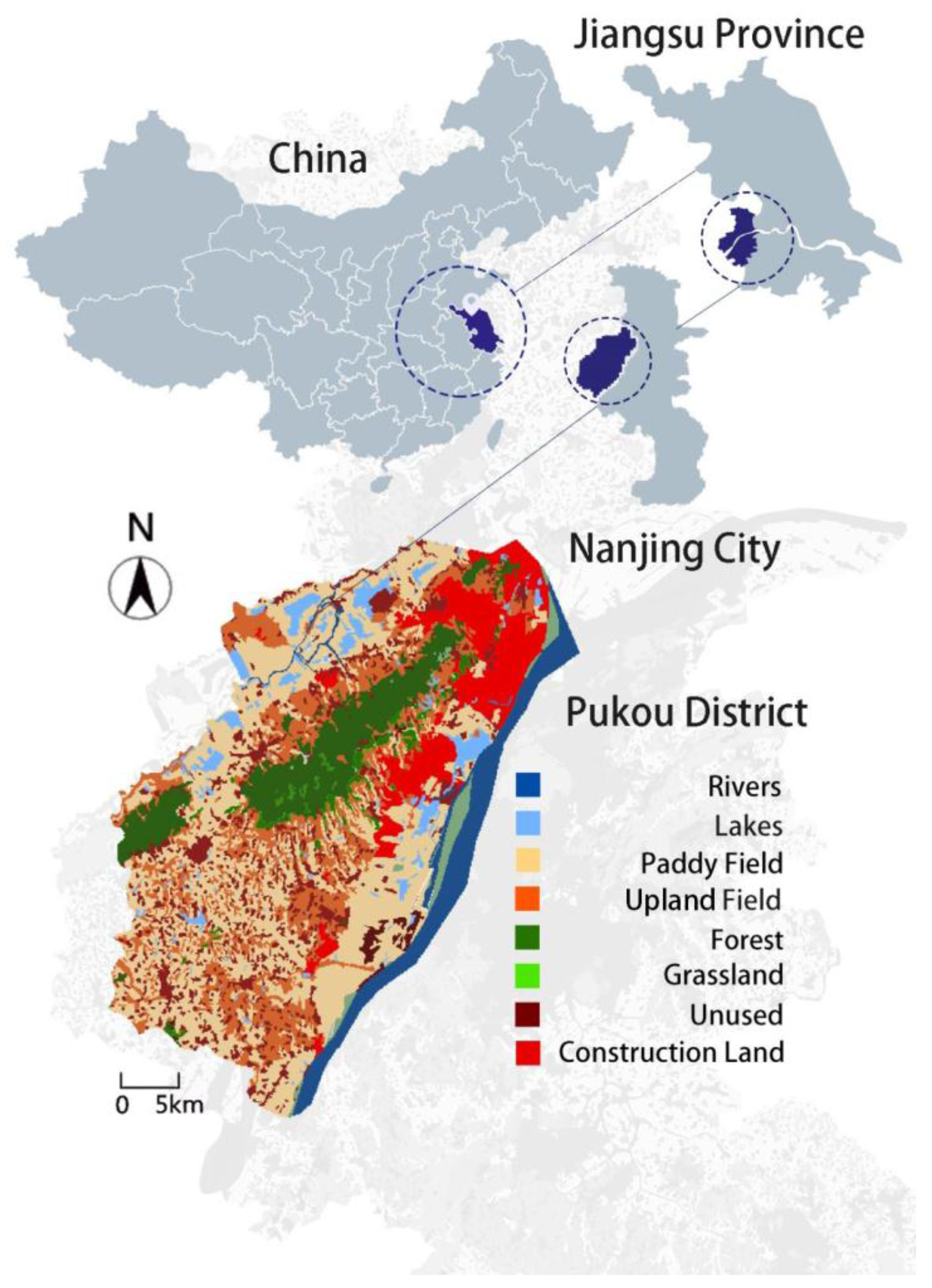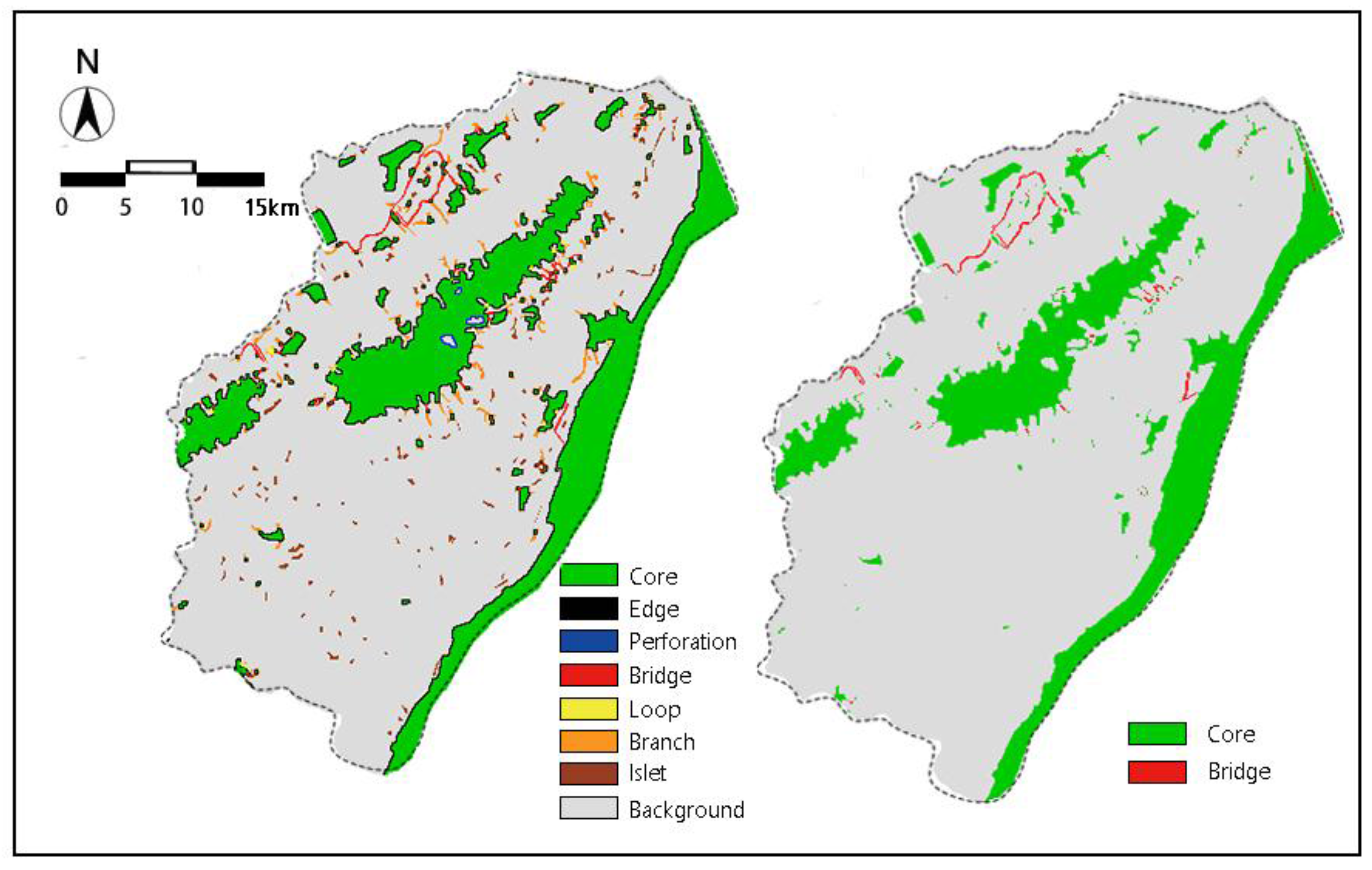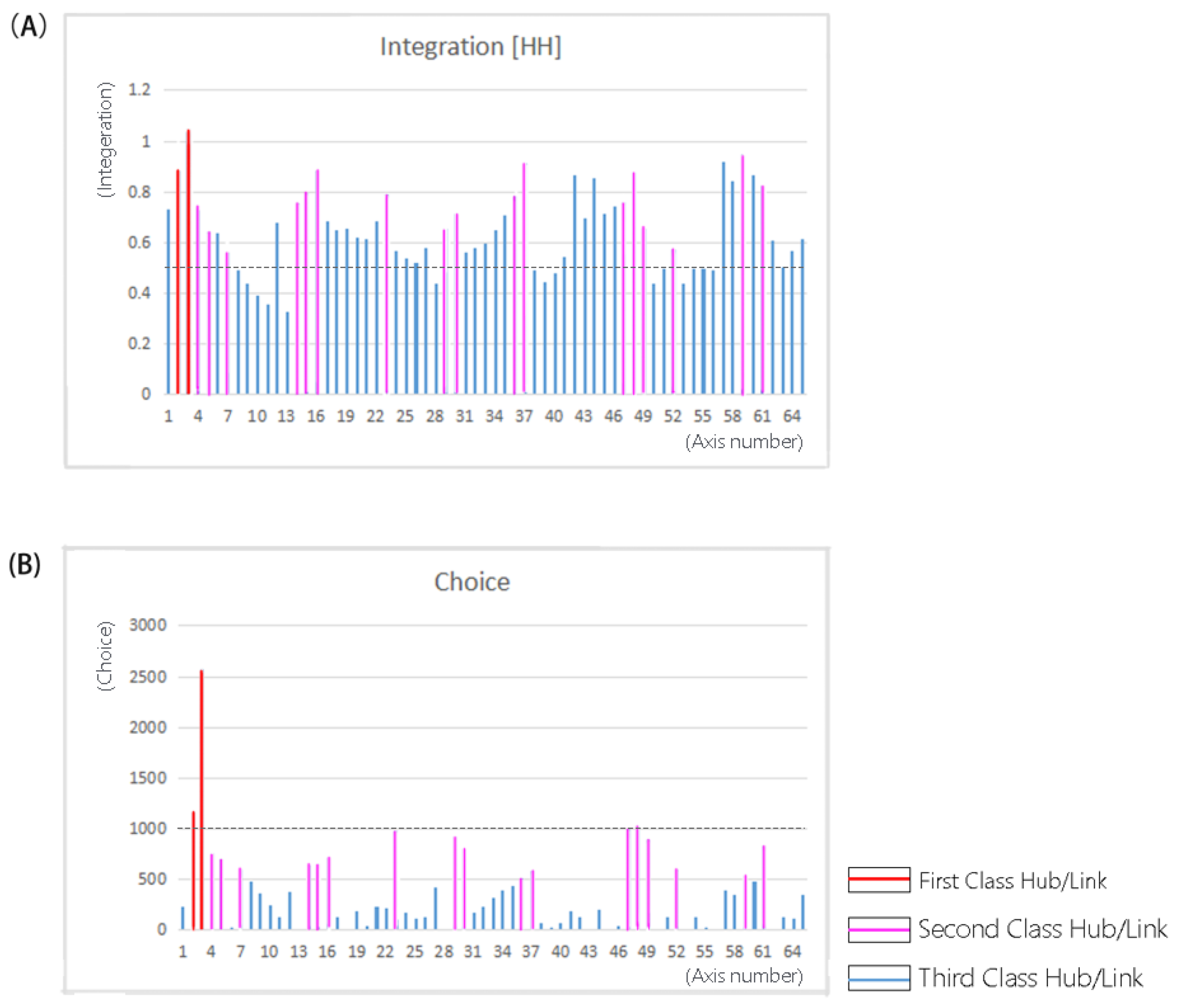Evaluating Spatial Priority of Urban Green Infrastructure for Urban Sustainability in Areas of Rapid Urbanization: A Case Study of Pukou in China
Abstract
:1. Introduction
2. Materials and Methods
2.1. Study Area
- The green infrastructures in the Pukou District (including woodlands, agricultural lands, wetlands, etc.) have been highly fragmented due to the rapid expansion of the built-up area over the past several decades and pose great pressure on biodiversity conservation with decreased connectivity between the increasingly isolated GI patches.
- The native plant communities were severely damaged by urban sprawl but they play an important role in biodiversity preservation.
- The Pukou District has been a hotspot region of urban growth in Nanjing and has become more critical in coordinating the relationship between urbanization and nature conservation for achieving the goal of smart growth.
2.2. Method
2.2.1. Phase 1: Extracting the UGI Elements
2.2.2. Phase 2: Identifying UGI Hubs and Links
2.2.3. Phase 3: Generating the Potential UGI Network
2.2.4. Phase 4: Evaluating the Priority of UGI Network Elements
3. Results
3.1. Identifying the GI Network Elements
3.2. Identifying the UGI Hubsand Links
3.3. Identifying Potential Links in the UGI Network
3.4. Priority Evaluation of UGI Network
4. Discussion
4.1. Identifying the Current Status of UGI
4.2. Implications and Limitation for Space Syntax
4.3. Application Prospects for UGI Planning and Management
4.4. Uncertainty and Future Perspectives
5. Conclusions
Acknowledgments
Author Contributions
Conflicts of Interest
References
- Forman, R.T.; Wu, J. Where to put the next billion people. Nature 2016, 537, 608–611. [Google Scholar] [CrossRef] [PubMed]
- Andersson, E.; Barthel, S.; Borgström, S.; Colding, J.; Elmqvist, T.; Folke, C.; Gren, Å. Reconnecting cities to the biosphere: Stewardship of green infrastructure and urban ecosystem services. Ambio 2014, 43, 445–453. [Google Scholar] [CrossRef] [PubMed]
- Carr, M.H.; Hoctor, T.D.; Goodison, C.; Zwick, P.D.; Green, J.; Hernandez, P.; McCain, C.; Teisinger, J.; Whitney, K. Final Report: Southeastern Ecological Framework; University of Florida: Gainesville, FL, USA, 2002. [Google Scholar]
- McNicoll, G. ; United Nations. Department of Economic and Social Affairs: World Economic and Social Survey 2004: International Migration. Pop. Dev. Rev. 2005, 31, 183–185. [Google Scholar]
- Lindholm, G. The Implementation of Green Infrastructure: Relating a General Concept to Context and Site. Sustainability 2017, 9, 610. [Google Scholar] [CrossRef]
- Tan, Y.; Tan, L.; Zhao, X. Differentiation of Commercial Activities and Urban Structural Change in Commercial Space: Based on Changsha City. Urban Stud. 2011, 6, 5. [Google Scholar]
- Yu, K. Landscape ecological security patterns in biological conservation. Acta Ecol. Sin. 1998, 19, 8–15. [Google Scholar]
- Vierikko, K.; Elands, B.; Niemelä, J.; Andersson, E.; Buijs, A.; Fischer, L.K.; Haase, D.; Kabisch, N.; Kowarik, I.; Luz, A.C. Considering the ways biocultural diversity helps enforce the urban green infrastructure in times of urban transformation. Curr. Opin. Environ. Sustain. 2016, 22, 7–12. [Google Scholar] [CrossRef]
- Angelstam, P.; Khaulyak, O.; Yamelynets, T.; Mozgeris, G.; Naumov, V.; Chmielewski, T.J.; Elbakidze, M.; Manton, M.; Prots, B.; Valasiuk, S. Green infrastructure development at European Union’s eastern border: Effects of road infrastructure and forest habitat loss. J. Environ. Manag. 2017, 193, 300–311. [Google Scholar] [CrossRef] [PubMed]
- Sikorska, D.; Sikorski, P.; Hopkins, R.J. High Biodiversity of Green Infrastructure Does Not Contribute to Recreational Ecosystem Services. Sustainability 2017, 9, 334. [Google Scholar] [CrossRef]
- Hu, D.; Zong, Y.; Xu, W. Research on the Construction of Landscape Ecological Security Pattern in the New Urban Region Development based on Ecology Network Analysis. Urban Stud. 2011, 6, 8. [Google Scholar]
- Barau, A.S. Perceptions and contributions of households towards sustainable urban green infrastructure in Malaysia. Habitat Int. 2015, 47, 285–297. [Google Scholar] [CrossRef]
- Jayasooriya, V.M.; Ng, A.W.M.; Muthukumaran, S.; Perera, B.J.C. Green infrastructure practices for improvement of urban air quality. Urban For. Urban Green. 2017, 21, 34–47. [Google Scholar] [CrossRef]
- Kim, R. Low Impact Development and Green Infrastructure in South Korea: Trends and Future Directions. Ecol. Resil. Infrastruct. 2016, 3, 80–91. [Google Scholar] [CrossRef]
- Meerow, S.; Newell, J.P. Spatial planning for multifunctional green infrastructure: Growing resilience in Detroit. Landsc. Urban Plan. 2017, 159, 62–75. [Google Scholar] [CrossRef]
- Langemeyer, J.; Gómez-Baggethun, E.; Haase, D.; Scheuer, S.; Elmqvist, T. Bridging the gap between ecosystem service assessments and land-use planning through Multi-Criteria Decision Analysis (MCDA). Environ. Sci. Policy 2016, 62, 45–56. [Google Scholar] [CrossRef]
- Lookingbill, T.R.; Minor, E.S. Assessing multi-scale landscape connectivity using network analysis. Learn. Landsc. Ecol. 2017, 193–209. [Google Scholar] [CrossRef]
- Flynn, K.M.; Traver, R.G. Green infrastructure life cycle assessment: A bio-infiltration case study. Ecol. Eng. 2013, 55, 9–22. [Google Scholar] [CrossRef]
- Meier, K.; Kuusemets, V.; Luig, J.; Mander, Ü. Riparian buffer zones as elements of ecological networks: Case study on Parnassius mnemosyne distribution in Estonia. Ecol. Eng. 2005, 24, 531–537. [Google Scholar] [CrossRef]
- Wickham, J.D.; Riitters, K.H.; Wade, T.G.; Vogt, P. A national assessment of green infrastructure and change for the conterminous United States using morphological image processing. Landsc. Urban Plan. 2010, 94, 186–195. [Google Scholar] [CrossRef]
- Cook, E.A. Landscape structure indices for assessing urban ecological networks. Landsc. Urban Plan. 2002, 58, 269–280. [Google Scholar] [CrossRef]
- Qiu, Y.; Chang, Q.; Wang, J. A MSPA-based Planning of Urban Green Infrastructure Network—A Case of Shenzhen. Chin. Landsc. Archit. 2013, 5, 104–108. [Google Scholar]
- Vogt, P.; Riitters, K.H.; Estreguil, C.; Kozak, J.; Wade, T.G.; Wickham, J.D. Mapping spatial patterns with morphological image processing. Landsc. Ecol. 2007, 22, 171–177. [Google Scholar] [CrossRef]
- Batty, M.; Rana, S. Reformulating Space Syntax: The Automatic Definition and Generation of Axial Lines and Axial Maps; Centre for Advanced Spatial Analysis Working Paper 58; Centre for Advanced Spatial Analysis University College London: London, UK, 2002. [Google Scholar]
- Omer, I.; Kaplan, N. Using space syntax and agent-based approaches for modeling pedestrian volume at the urban scale. Comput. Environ. Urban Syst. 2017, 64, 57–67. [Google Scholar] [CrossRef]
- Mell, I.C.; Henneberry, J.; Hehl-Lange, S.; Keskin, B. To green or not to green: Establishing the economic value of green infrastructure investments in The Wicker, Sheffield. Urban For. Urban Green. 2016, 18, 257–267. [Google Scholar] [CrossRef]
- Chiang, Y.C.; Yang, D. City gate as key towards sustainable urban redevelopment: A case study of ancient Gungnae City within the modern city of Ji’an. Habitat Int. 2017, 67, 1–12. [Google Scholar] [CrossRef]
- Ratti, C. Space syntax: Some inconsistencies. Environ. Plan. B Plan. Des. 2004, 31, 487–499. [Google Scholar] [CrossRef]
- Chang, Q.; Liu, X.; Wu, J.; He, P. MSPA-based urban green infrastructure planning and management approach for urban sustainability: Case study of Longgang in China. J. Urban Plan. Dev. 2014, 141, A5014006. [Google Scholar] [CrossRef]
- Cheng, L.; Xia, N.; Jiang, P.; Zhong, L.; Pian, Y.; Duan, Y.; Huang, Q.; Li, M. Analysis of farmland fragmentation in China Modernization Demonstration Zone since “Reform and Openness”: A case study of South Jiangsu Province. Sci. Rep. 2015, 5, 11797. [Google Scholar] [CrossRef] [PubMed]
- Xie, M.; Gao, Y.; Jürgen, B.; Fu, C.; Tong, D. Dynamics and Temperature Regulation Function of Urban Green Connectivity. J. Urban Plan. Dev. 2014, 141, A5014008. [Google Scholar] [CrossRef]
- Zhu, Q.; Yu, K.; Li, D. The width of ecological corridor in landscape planning. Acta Ecol. Sin. 2005, 25, 2406–2412. [Google Scholar]
- Teng, M. Planning Ecological Security Patterns in Rapidly Urbanization Context: A Case Study in Wuhan, China; Huazhong Agricultural University: Wuhan, China, 2011. [Google Scholar]
- Landguth, E.; Hand, B.; Glassy, J.; Cushman, S.; Sawaya, M. UNICOR: A species connectivity and corridor network simulator. Ecography 2012, 35, 9–14. [Google Scholar] [CrossRef]
- Chen, L.; Fu, B.; Xu, J.; Gong, J. Location-weighted landscape contrast index: A scale independent approach for landscape pattern evaluation based on source-sink ecological processes. Acta Ecol. Sin. 2002, 23, 2406–2413. [Google Scholar]
- Xu, F.; Kong, F.; Xu, J. Developing ecological networks based on mspa and the least-cost path method: A case study in bazhong western new district. Acta Ecol. Sin. 2015, 35, 6425–6434. [Google Scholar]
- Knaapen, J.P.; Scheffer, M.; Harms, B. Estimating habitat isolation in landscape planning. Landsc. Urban Plan. 1992, 23, 1–16. [Google Scholar] [CrossRef]
- Hillier, B.; Yang, T.; Turner, A. Normalising least angle choice in Depthmap and how it opens new perspectives on the global and local analysis of city space. J. Space Syntax 2012, 3, 155–193. [Google Scholar]
- Velázquez, J.; Gutiérrez, J.; Hernando, A.; García-Abril, A. Evaluating landscape connectivity in fragmented habitats: Cantabrian capercaillie (Tetrao urogallus cantabricus) in northern Spain. For. Ecol. Manag. 2017, 389, 59–67. [Google Scholar] [CrossRef]
- Kong, F.; Yin, H.; Nakagoshi, N. Using GIS and landscape metrics in the hedonic price modeling of the amenity value of urban green space: A case study in Jinan City, China. Landsc. Urban Plan. 2007, 79, 240–252. [Google Scholar] [CrossRef]
- Benedict, M.A.; McMahon, E. Green Infrastructure: Linking Landscapes and Communities. Nat. Areas J. 2017, 3, 282–283. [Google Scholar]
- Chen, C.; Meurk, C.D.; Jia, Z.; Lv, M.; Wu, S.; Jia, J. Incorporating landscape connectivity into household pond configuration in a hilly agricultural landscape. Landsc. Ecol. Eng. 2017, 13, 189–204. [Google Scholar] [CrossRef]
- Hillier, B. Space Is The Machine: A Configurational Theory Of Architecture. J. Urban Design. 2007, 3, 333–335. [Google Scholar]
- Zhao, J.; Yu, Y.; Wang, X.; Kan, X. Economic impacts of accessibility gains: Case study of the Yangtze River Delta. Habitat Int. 2017, 66, 65–75. [Google Scholar] [CrossRef]
- Forman, R.T. Urban ecology principles: Are urban ecology and natural area ecology really different? Landsc. Ecol. 2016, 31, 1653–1662. [Google Scholar] [CrossRef]
- Roe, M.; Mell, I. Negotiating value and priorities: Evaluating the demands of green infrastructure development. J. Environ. Plan. Manag. 2013, 56, 650–673. [Google Scholar] [CrossRef]
- Hoerbinger, S.; Immitzer, M.; Obriejetan, M.; Rauch, H.P. GIS-based assessment of ecosystem service demand concerning green infrastructure line-side vegetation. Ecol. Eng. 2017, 10–19. [Google Scholar] [CrossRef]
- Bolund, P.; Hunhammar, S. Ecosystem services in urban areas. Ecol. Econ. 1999, 29, 293–301. [Google Scholar] [CrossRef]
- Wu, J.; Hobbs, R. Key issues and research priorities in landscape ecology: An idiosyncratic synthesis. Landsc. Ecol. 2002, 17, 355–365. [Google Scholar] [CrossRef]
- Costanza, R.; Groot, R.D.; Braat, L.; Kubiszewski, I.; Fioramonti, L.; Sutton, P.; Farber, S.; Grasso, M. Twenty years of ecosystem services: How far have we come and how far do we still need to go? Ecosyst. Serv. 2017, 28, 1–16. [Google Scholar] [CrossRef]









| Concept | Ecological Meaning |
|---|---|
| Core | Foreground pixels surrounded on all sides by foreground pixels and greater than the specified edge width distance from background. |
| Islet | Foreground pixels that do not contain a core. The islet is the only unconnected class. Edges and perforations surround the core, and loops, bridges and branches are connected to the core. |
| Perforation | Pixels that form the transition zone between foreground and background for interior regions of the foreground. Consider a group of foreground pixels in the shape of a doughnut. The pixels forming the inner edge would be classified as perforations, whereas those forming the outer edge would be classified as edge. |
| Edge | Pixels that form the transition zone between the foreground and background. |
| Bridge | Foreground pixels that connect two or more disjunct areas of the core. |
| Loop | Foreground pixels that connect an area of the core to itself. |
| Branch | Foreground pixels that extend from an area of the core but do not connect to another area of the core. |
| Choice | >1000 | 500~1000 | <500 | |
|---|---|---|---|---|
| General Integration | ||||
| >0.5 | First Class | Second Class | Third Class | |
| <0.5 | Second Class | Third Class | Third Class | |
| Landscape Type | Area (km2) | Percentage of Total UGI Area (%) | Percentage of Total Research Area (%) |
|---|---|---|---|
| Core | 164.34 | 71.62 | 18 |
| Islet | 8.22 | 3.73 | 0.9 |
| Perforation | 0.71 | 0.31 | 0 |
| Edge | 35.61 | 15.79 | 3.9 |
| Bridge | 4.57 | 2.21 | 0.5 |
| Loop | 0.91 | 0.61 | 0.1 |
| Branch | 12.78 | 5.74 | 1.4 |
| Importance | Node | dPC |
|---|---|---|
| 1 | 34 | 56.89524 |
| 2 | 22 | 44.50363 |
| 3 | 81 | 3.667665 |
| 4 | 19 | 2.854003 |
| 5 | 70 | 1.468259 |
| 6 | 68 | 1.22869 |
| 7 | 24 | 1.021085 |
| 8 | 9 | 0.830746 |
| 9 | 73 | 0.7061991 |
| 10 | 44 | 0.6329749 |
© 2018 by the authors. Licensee MDPI, Basel, Switzerland. This article is an open access article distributed under the terms and conditions of the Creative Commons Attribution (CC BY) license (http://creativecommons.org/licenses/by/4.0/).
Share and Cite
Wei, J.; Qian, J.; Tao, Y.; Hu, F.; Ou, W. Evaluating Spatial Priority of Urban Green Infrastructure for Urban Sustainability in Areas of Rapid Urbanization: A Case Study of Pukou in China. Sustainability 2018, 10, 327. https://doi.org/10.3390/su10020327
Wei J, Qian J, Tao Y, Hu F, Ou W. Evaluating Spatial Priority of Urban Green Infrastructure for Urban Sustainability in Areas of Rapid Urbanization: A Case Study of Pukou in China. Sustainability. 2018; 10(2):327. https://doi.org/10.3390/su10020327
Chicago/Turabian StyleWei, Jiaxing, Jing Qian, Yu Tao, Feng Hu, and Weixin Ou. 2018. "Evaluating Spatial Priority of Urban Green Infrastructure for Urban Sustainability in Areas of Rapid Urbanization: A Case Study of Pukou in China" Sustainability 10, no. 2: 327. https://doi.org/10.3390/su10020327





